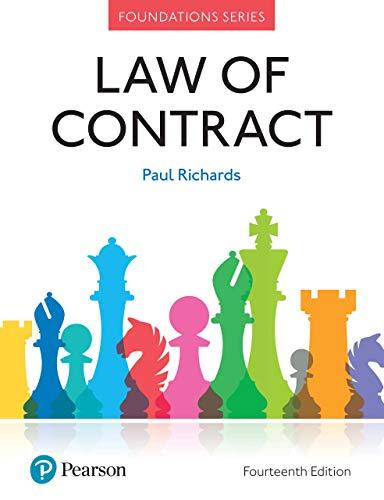Question
Suggest a case briefing using the IRAC method? 14 PENN PLAZA LLC. V. PYETT 129 S. Ct. 1456 (2009) The Service Employees International Union is
Suggest a case briefing using the IRAC method?
14 PENN PLAZA LLC. V. PYETT 129 S. Ct. 1456 (2009)
The Service Employees International Union is the exclusive bargaining representative of its members. These members are building cleaners, porters, and doorpersons working in New York City. The union has a collective bargaining agreement (CBA) with the Realty Advisory Board on Labor Relations Inc. (RAB), a multiemployer bargaining association for the New York City real estate industry. The CBA contains a commitment to nondiscrimination based on race, creed, color, age, disability, national origin, sex, union membership, or any other characteristic protected by law. The CBA further states that all claims of discrimination shall be subject to arbitration procedures specified in the CBA as the sole and exclusive remedy for such violations. 14 Penn Plaza LLC is a member of the RAB. As an owner of an office building, 14 Penn Plaza hired unionized workers as night lobby watchmen. Later, 14 Penn Plaza, with the union's consent, employed licensed security guards to staff the lobby and entrances of its building. This hiring resulted in the night lobby watchmen being reassigned as night porters and cleaners. These latter jobs paid less than the watchmen positions. These union members, including Mr. Pyett, filed a complaint with the Equal Employment Opportunity Commission (EEOC) on the grounds of age discrimination by 14 Penn Plaza, their employer. The EEOC did not find a violation but granted the employees/union members the right to sue their employer. A lawsuit alleging age discrimination was filed, and 14 Penn Plaza sought to have the case dismissed. A motion to compel arbitration, as required under the CBA, was denied by the District Court for the Southern District of New York. On appeal, the Second Circuit affirmed this decision stating that a CBA cannot deny an employee's opportunity to litigate federal statutory protected right. The Supreme Court granted certiorari to review that decision. THOMAS, J.: The question presented by this case is whether a provision in a collective-bargaining agreement that clearly and unmistakably requires union members to arbitrate claims arising under the Age Discrimination in Employment Act of 1967 (ADEA) is enforceable. The United States Court of Appeals for the Second Circuit held that this Court's decision in Alexander v. Gardner-Denver Co., 415 U. S. 36 (1974), forbids enforcement of such arbitration provisions. We disagree and reverse the judgment of the Court of Appeals. . . . In this instance, the Union and the RAB, negotiating on behalf of 14 Penn Plaza, collectively bargained in good faith and agreed that employment-related discrimination claims, including claims brought under the ADEA, would be resolved in arbitration. This freely negotiated term between the Union and the RAB easily qualifies as a condition of employment that is subject to mandatory bargaining. . . . The decision to fashion a CBA to require arbitration of employment-discrimination claims is no different from the many other decisions made by parties in designing grievance machinery. Respondents, however, contend that the arbitration clause here is outside the permissible scope of the collective-bargaining process because it affects the employees' individual, non-economic statutory rights. We disagree. Parties generally favor arbitration precisely because of the economics of dispute resolution. As in any contractual negotiation, a union may agree to the inclusion of an arbitration provision in a collective-bargaining agreement in return for other concessions from the employer. Courts generally may not interfere in this bargained-for exchange. Judicial nullification of contractual concessions . . . is contrary to what the Court has recognized as one of the fundamental policies of the National Labor Relations Act freedom of contract. As a result, the CBA's arbitration provision must be honored unless the ADEA itself removes this particular class of grievances from the NLRA's broad sweep. Itpage 136 does not. This Court has squarely held that the ADEA does not preclude arbitration of claims brought under the statute. . . . Gardner-Denver mistakenly suggested that certain features of arbitration made it a forum well suited to the resolution of contractual disputes, but a comparatively inappropriate forum for the final resolution of rights created by Title VII. . . . These misconceptions have been corrected. For example, the Court has recognized that arbitral tribunals are readily capable of handling the factual and legal complexities of antitrust claims, notwithstanding the absence of judicial instruction and supervision and that there is no reason to assume at the outset that arbitrators will not follow the law. An arbitrator's capacity to resolve complex questions of fact and law extends with equal force to discrimination claims brought under the ADEA. Moreover, the recognition that arbitration procedures are more streamlined than federal litigation is not a basis for finding the forum somehow inadequate; the relative informality of arbitration is one of the chief reasons that parties select arbitration. Parties trade the procedures and opportunity for review of the courtroom for the simplicity, informality, and expedition of arbitration. In any event, it is unlikely that age discrimination claims require more extensive discovery than other claims that we have found to be arbitrable, such as RICO and antitrust claims. . . . We hold that a collective-bargaining agreement that clearly and unmistakably requires union members to arbitrate ADEA claims is enforceable as a matter of federal law. The judgment of the Court of Appeals is reversed, and the case is remanded for further proceedings consistent with this opinion. Reversed and remanded.
Step by Step Solution
There are 3 Steps involved in it
Step: 1

Get Instant Access to Expert-Tailored Solutions
See step-by-step solutions with expert insights and AI powered tools for academic success
Step: 2

Step: 3

Ace Your Homework with AI
Get the answers you need in no time with our AI-driven, step-by-step assistance
Get Started


